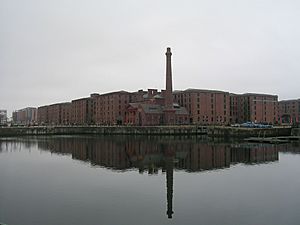Philip Hardwick facts for kids
Quick facts for kids
Philip Hardwick
|
|
|---|---|

c.1850
|
|
| Born | 15 June 1792 |
| Died | 28 December 1870 (aged 78) |
| Nationality | British |
| Occupation | Architect |
Philip Hardwick (born 15 June 1792 in London – died 28 December 1870) was a famous English architect. He is especially known for designing railway stations and large warehouses in London and other places. Hardwick is probably most famous for the Euston Arch in London, which was later taken down. He also designed the original Birmingham Curzon Street Station, which is still standing today and is the oldest railway station building in the world.
Contents
Who Was Philip Hardwick?
Philip Hardwick was born in London in 1792. He came from a family of architects. His father, Thomas Hardwick Jr., and his grandfather, Thomas Hardwick Sr., were also architects. The Hardwick family worked in British architecture for over 150 years!
Philip studied at the Royal Academy Schools starting in 1808. He then traveled and studied in France and Italy from 1815 to 1819. After his travels, he took over from his father as the main surveyor (a type of architect who checks buildings) for St Bartholomew's Hospital in London. Later, Philip's own son, Philip Charles Hardwick, took on this role. This means three generations of Hardwicks worked for the hospital!
Designing Important Buildings
In 1825, Philip Hardwick became the architect for the St Katherine's Dock Company. He designed the buildings around the docks, while Thomas Telford designed the docks themselves. In 1829, he designed a new hall for the Goldsmiths' Company, which opened in 1835.

Hardwick became the architect for the London and Birmingham Railway in 1836. He built a huge entrance called a "Doric propylaeum" for the railway's Euston Station. This grand entrance became known as the "Euston Arch." In 1838, he also built the Curzon Street Station in Birmingham. This building was simple but strong, with four large Ionic columns at the front.
Philip Hardwick used different styles in his designs. For example, at Babraham Hall (1822–1823), he used a Jacobean style with red bricks and stone. At Lincoln's Inn (1843–1845), he worked with his son to build a new hall and library in a Tudor style, using red and black bricks. For churches, he used both the classical style, like at Christ Church in Marylebone (1824–1825), and the Gothic style, like at Holy Trinity in Bolton (1823–1825).
Hardwick was also known as a surveyor. He worked for important places like the Westminster Bridge estates and Greenwich Hospital. He even helped design Wellington Barracks near Buckingham Palace in 1833.
Awards and Recognition
In 1831, Philip Hardwick became a member of the Royal Society. He was also one of the people who started the Institute of British Architects in 1834, which later became the RIBA. In 1839, he became an associate of the Royal Academy, and then a full Royal Academician in 1841.
In 1854, he received the seventh Royal Gold Medal for architecture, a very important award.
Family and Students
Philip Hardwick married Julia Shaw in 1819. Julia's father and brother were also architects. Philip had two sons. His younger son, Philip Charles Hardwick, born in 1822, also became an architect and worked with his father.
Many students learned from Philip Hardwick. Some of them became famous architects themselves, like John Loughborough Pearson, who designed Truro Cathedral.
Hardwick was good friends with the famous artist J. M. W. Turner. Turner even chose Hardwick to manage his will after he passed away in 1851. Philip Hardwick and many of his family members are buried at Kensal Green Cemetery.
The Euston Arch Story
The Euston Arch was probably Philip Hardwick's most famous work. He designed it in 1837 for the old Euston Station. It was a huge, grand entrance that cost a lot of money to build. Hardwick was inspired by buildings he saw during his trip to Italy.
Sadly, even though many people tried to save it, the Euston Arch was taken down in the early 1960s. The gates from the arch are now kept at the National Railway Museum in York. In 1994, a historian found about 60% of the arch's stones buried in a riverbed in London! This discovery means that one day, the Euston Arch might be rebuilt.
Other Projects

Philip Hardwick designed many other important buildings throughout his career. Here are a few:
- Warehouses at St Katharine Docks (1827–1828)
- The third Goldsmiths' Hall (1829–1835)
- The City of London Club, known for its Italian style (1833–1834)
- The Great Hall at Lincoln's Inn (1843–1845), where he worked with his son
- Warehouses at the Albert Dock in Liverpool (1846–1847), which are now part of a famous UNESCO World Heritage Site
- The Royal Freemasons' School for Girls in Wandsworth (1851)
- The Obelisk memorial for explorer Joseph René Bellot in Greenwich (1855)



